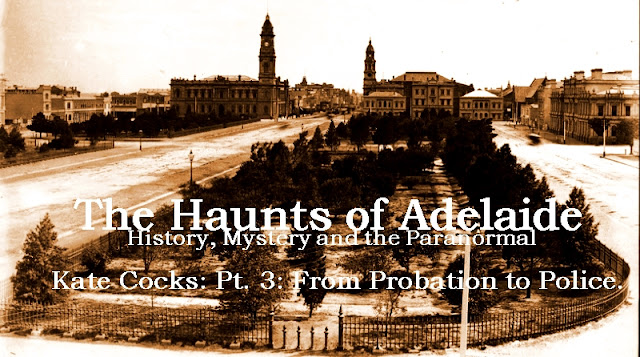A Haunting at the
Supreme Court of South Australia
Why would someone
haunt the Supreme Court of South Australia? That is a question one could ask
about any building, but a pertinent question after it came to light in January
2019, that the Adelaide Supreme Court was receiving changes to a proposed internal
renovation due to a ghost!
The Adelaide Supreme
Court was designed by Colonial Architect, R.G. Thomas. The building was
constructed using Tea Tree Gully sandstone in 1869. The building was first used
as the Local Court and Insolvency Court, then from 1873, it became solely the
Supreme Court.[1]
The building is part of a group of significant
law buildings facing Victoria Square that also includes the Sir Samuel Way
Court, the Magistrates Court, and the original Police Courts.[2]
The Supreme Court of Adelaide has been home to
some very notable South Australian’s including Sir Samuel Way, Sir Mellis
Napier, Sir James Boucat, Sir Herbert Mayo, and Dame Roma Mitchell just to name
a few. Another Judge, and the suspected ghost haunting the Adelaide Supreme
Court, is Sir George John Robert Murray (1863-1942).
Judge Murray was born at Magill, the son
of Scottish pastoralists. He was educated at J.L. Youngs’s Adelaide Educational
Institution, and attended the Royal High School, Edinburgh, Scotland.[3] He returned to South Australia and attended
St. Peter’s College, then the University of Adelaide. He obtained a scholarship
for his outstanding marks, which allowed him to attend law school at Trinity
College, Cambridge, UK.[4]
Murray had a distinguished career, now only as
a lawyer and Judge. He was appointed a Judge of the Supreme Court of South
Australia in 1912. He also served as Chancellor for the University of Adelaide
six times between 1916 and 1942. In 1916 he became the Chief Justice of South
Australia. Murray also administered the government of South Australia, as the
states Lieutenant Governor on numerous occasions in the absence of a Governor. In
1917, Murray was honoured with Knight Commander (KCMG), The Most
Distinguished Order of Saint Michael and Saint George.[5]
Murray was seen by
many as an austere and serious man. He never married, and instead lived with
his unmarried sister, Margaret at the family estate, Murray Park at Magill (now
the administrative building of University of South Australia, Magill Campus).[6]
Sir Murray died on
18 February 1942 following an operation for appendicitis. He was buried alongside
his sister at St Georges Church of England Cemetery, Woodforde (near Magill).
It was alleged in numerous newspaper reports,
that during the renovations of the Adelaide Supreme Court in 2018-19 that a psychic medium, brought in by construction company Hansen Yuncken, identified
Sir George Murray as a resident ghost in the building.
Construction workers had reported
strange goings-on in the old building. Chairs had moved through the worksite of
their own volition. Fire extinguishers, placed in areas of high risk, would be
found in entirely different sections of the worksite far from where workers had
placed them. I personally had contact from security guards who told me they had
seen the spectre of a man walk through the building, his presence was solid
enough that when he walked past motion-activated doors, they would open.
Some staff became ‘spooked’ by the
ghost, so the psychic was called on to investigate. It is claimed the psychic
ran her hand over the proposed plans of the building and “felt a presence”. She
spoke psychically to the spirit and later identified him via a portrait of Sir
Murray. She stated that Sir Murray objected to the proposed seating rearrangement
of where the Judges sat in courtroom 11.
A spokesperson for
Hansen Yuncken stated:
'Apparently she
spoke to what she called the 'spirit', which was a Supreme Court Judge, Sir
George Murray, who was a little bit annoyed that the layout of his courtroom
had changed so he has been causing a little bit of mayhem.'
The spokesperson went on to say; 'There might be a little bit of a design
change to keep the judge happy. There may well be some things to accommodate
his, shall we say, temper.'[7]
Sir George Murray was the States Supreme
Justice for 16 years and served at the courtrooms from 1912 until his death in
1942. Perhaps, it is justified that his presence is felt in the courts…
Researched and written by Allen Tiller © 2020
(Written for the publication; Haunted Adelaide)
[1]
Adelaide Heritage, Supreme Court, National Trust of South Australia, (2019), http://www.adelaideheritage.net.au/all-site-profiles/supreme-court/.
[2] Ibid.
[3]
‘Death of Sir George Murray’, The Advertiser, (19 February 1942), p. 4.
[4]
Alex C. Castles, 'Murray, Sir George John Robert (1863–1942)', Australian
Dictionary of Biography, National Centre of Biography, ANU, (1986), http://adb.anu.edu.au/biography/murray-sir-george-john-robert-7708/text13497.
[5]
Peter Duckers, British Orders and Decorations, (Oxford 2009), pp. 26–27.
[6] Jim
Nelson, Murray Park House, Campbelltown City Council, https://www.campbelltown.sa.gov.au/library/local-history-room/localhistoryarticles/local-history-articles-places/murray-park-house.
[7] Brittany
Chain, $31 million Supreme Court renovations halted after medium declares the
spirit of a dead judge is haunting the building – as plans are rearranged to ‘appease
the ghost’, Daily Mail Australia, (20 Jan 2019), https://www.dailymail.co.uk/news/article-6611759/Supreme-Court-renovations-halted-medium-declares-spirit-dead-judge-haunting-building.html.






%2C%2BSaturday%2B2%2BJuly%2B1949%2C%2Bpage%2B3.jpg)

%2C%2BSaturday%2B24%2BJuly%2B1954%2C%2Bpage%2B3.jpg)